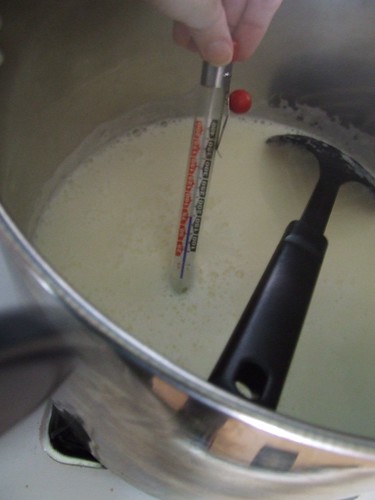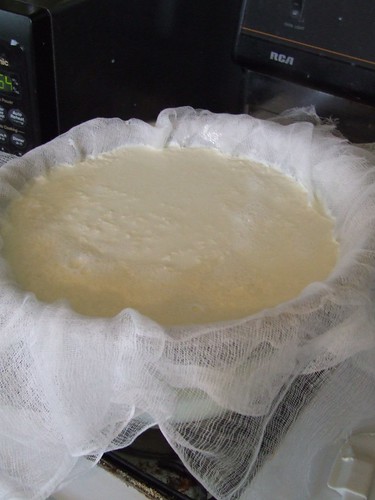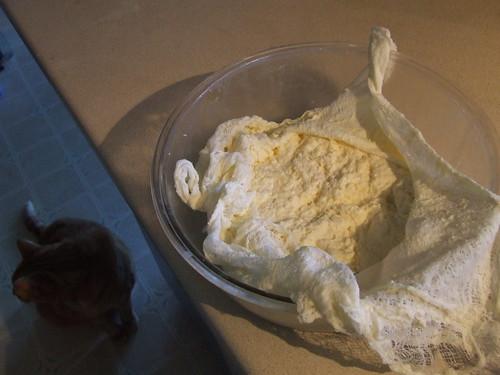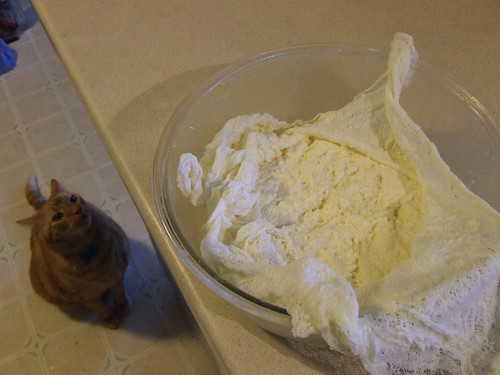
In things I have been planning to blog about, I made ricotta from scratch at the end of last month. I had a gallon of raw whole milk from some friends who bought a share at a small local dairy for the summer. They went to Burning Man, and I got their last gallon of milk. I had to use it quickly, before it went bad, and before we left for Labor Day weekend in Atlanta. I decided to make some cheese.
I had made cheese before, using a kit my mother bought from New England Cheese Making Supply Company. We made mozzarella, then we made ricotta from the whey. I found that I couldn't make mozzarella on the spot, though, because I had no rennet, so I decided to make an extra-rich ricotta. I was excited about using the raw cheese, because it was organic, and the organic milk I can normally get at the grocery store is ultra-pasteurized, which denatures the proteins, and makes it unsuitable for cheese making. I had a recipe from Smitten Kitchen that was even richer, since it includes heavy cream, but I didn't quite want to go that route since it seemed even farther from the traditional ricotta, and since this milk was extra-rich. This recipe was also for much smaller quantities of milk. I decided to do some more research and combine that recipe with others, especially after adding up the amount of lemon juice I would be using. I also used a recipe from About.com's Italian food section, a step-by-step tutorial from Wikihow, and information from The Food Lab. I found The Food Lab's comparisons to be especially helpful. I also have a recipe somewhere from a friend of Italian descent, but I couldn't find it at the time.

The first step to making ricotta is to heat the milk to the point at which it starts to simmer, 180ºF. My first recipe said a higher temperature, but according to the testers at The Food Kitchen, any temperature in the 165-185ºF rage works without noticeable difference. Also, note that although I was using raw milk, I raised it above 161ºF, which is the temperature at which milk is pasteurized, so I had no worries, even if I hadn't felt as confident in the milk's origin.
Once the milk is hot enough, it is removed from the heat and the acid is added. I chose to use distilled white vinegar because The Food Kitchen said it "gave the cleanest flavor, with soft, tender curds", and it was the most consistant. Once I had stirred that in, I added the salt. The curds began forming immediately.

After letting it sit and form curds for a little while, I dumped it into a colander lined with several layers of cheesecloth (Since I didn't have butter muslin) and let it strain into the bowl below. This wasn't the best way of doing it, because the draining took forever.
As you can see in the above picture, the whey was still pretty rich. In fact, it was richer than the whey I used the first time I made ricotta, after making mozzarella, so I decided to use it again, until it got thin. In the later batches, I added less vinegar.
The second time, I spooned the curds out of the whey, which was much more effective and drained much more quickly.
Here's the final product complete with dramatic lighting:

And here it is where you can see how intriguing Hoser finds it:

Either that, or he was just being a little furry diva:

Ricotta:
1 gallon milk
1/3 cup plus 1 teaspoon distilled white vinegar
1/4 teaspoon salt (more if you want a saltier taste)
Heat the milk between 165ºF and 185ºF, or the point at which it starts to simmer.
Remove from heat.
Gently stir in vinegar.
Add salt.
Allow to sit and curds to form.
Ladle curds into a colander lined with cheese cloth, over a bowl to catch excess liquid.
Allow to drain for at least 15 minutes, until it reaches desired consistency.
Continue to process your whey until it runs clear, addling less acid in each subsequent batch, and just mix the curds together.
I used the ricotta in lasagna. I also ate some fresh. It was fabulous. In retrospect, I should have made something that would have shown it off a little better, like ravioli, but it was still good. Honestly, it was pretty easy, too.
No comments:
Post a Comment